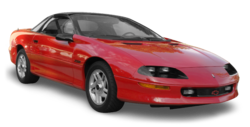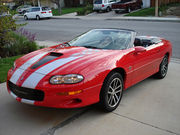Fourth-generation Chevrolet Camaro
| Fourth-generation Chevrolet Camaro | |
|---|---|
 | |
| Manufacturer | Chevrolet |
| Parent company | General Motors |
| Production | 1993-2002 |
| Assembly | Sainte-Thérèse, Quebec |
| Predecessor | Third–gen Camaro |
| Successor | Fifth–gen Camaro |
| Class | Pony car Muscle car Sports car |
| Body style(s) | 2-door coupé 2-door convertible |
| Layout | FR layout |
| Platform | F-body |
| Engine(s) | 204 cu in (3.3 L) 160 hp (119 kW) V6 350 cu in (5.7 L) 275 hp (205 kW) V8 231 cu in (3.8 L) 200 hp (149 kW) V6 346 cu in (5.7 L) 310 hp (231 kW) V8 346 cu in (5.7 L) 325 hp (242 kW) V8 |
| Transmission(s) | 4-speed automatic 5-speed manual 6-speed manual |
| Wheelbase | 101.1 in (257 cm) |
| Length | 193.2 in (491 cm) (93-97) 193.5 in (491 cm) (98-02) |
| Width | 74.1 in (188 cm) |
| Height | 51.2 in (130 cm) (cp) 51.8 in (132 cm) (cnvrt) |
| Related | Pontiac Firebird |
The fourth-generation Chevrolet Camaro was first seen at the end of 1992, but debuted for the 1993 model year on an updated F-body platform. It would retain the same characteristic since the first-generation's introduction back in 1967; 2-doors, 2+2 seating, available as a coupé (with optional T-top roof) or convertible, rear-wheel drive, and a choice of V6 and V8 powerplants. The 1998 model year was refreshed and revised with both exterior and engine changes. The fourth-gen Camaro would last up through the 2002 model year when General Motors discontinued production due to slow sales, a deteriorated sports coupe market, and plant overcapacity.
1993
1993 was the debut year for the fourth generation Camaro, and production continued until 2002. Production was moved from GM's Van Nuys, California, assembly plant to Sainte-Thérèse, Quebec, Canada in 1993. The new design incorporated lightweight plastic body panels over a steel spaceframe and a much improved suspension design. The 1993 Camaro also featured the LT1 V8 engine with 275 hp (205 kW) and 325 ft·lbf (441 N·m) torque that had been introduced in the Corvette one year earlier, as well as an optional Borg-Warner six-speed manual transmission when ordered with the V8. The Camaro was the first of many vehicles to use this gearbox. In 1993, the Camaro Z28 was selected as the official pace car for the Indianapolis 500. A pace car edition was produced in limited quantities with a unique black and white color scheme and multicolored pinstriping. Base Camaros were powered by a 160 hp (119 kW) 3.4 L V6.
1994
Mostly minor changes occurred for 1994. The 4L60 automatic transmission was replaced with the 4L60E which included electronic controls. Accordingly, the car's on-board computer was modified from dealing only with the engine as in 1993 and earlier, to controlling both the engine and transmission on automatic models. Dashboard gauge graphics were changed from yellow to white. The front brakes were revised on the Z28 model. Cooling fans were changed mid-year from a parallel to a series setup. On low both fans operated on 6V, but on high both operated on 12V.
1995
In 1995, base Camaros in California were equipped with the 3800 Series II engine for emissions compliance while base Camaros sold elsewhere retained the 3.4 L (207 cu in) engine. This would be the last year the 3.4 L (207 cu in) V6 engine would be available. For the LT1-powered Camaros, the often-problematic Opti-spark distributor was updated to include a vent to remove moisture from the unit. The cam drive system for the distributor was also changed, making "early" & "late" model cams and distributors non-interchangeable. 1995 was also the first year the fourth-generation Camaro had the option of painted side bars and mirrors. Traction control became available as an option on LT1 Camaros. Z28 rooftops and mirrors, which were previously only available in black, now had the option to be painted the same as the body color.
1996
1996 saw minor mechanical revisions, as well as small power gains from the new OBD II-compliant engine controls. All base model Camaros were now equipped with the 3800 series II. V8 models still came with the 5.7L LT1 engine. The dual catalytic converters required by OBD-II resulted in lower restriction and a mild power boost to 285 hp (213 kW) and 325 ft·lbf (441 N·m) of torque. Two option packages also returned: the RS, an appearance option for the V6 model, and the SS, a performance and appearance package for V8-powered cars. The SS cars, which were modified by Street Legal Performance (SLP) through contract with GM, were the highest factory performance Camaros offered at the time and included a functioning hood scoop and new five-spoke 17 in (43 cm) x 9 in (23 cm) wheels. The new wheel and tire package on the SS resulted in better handling and braking compared to the Z28. Also available this year for the V6 model was the Y87 package, which included an Auburn LSD, better tires, dual exhaust tips, 4 wheel disk brakes, and a sportier steering ratio.
1997
For the 1997 model year, the Camaro got a new interior and new tri-colored taillight that would be standard on all models from 1997 to 2002. It was offered with a "30th Anniversary Package" which included unique orange stripes on white base paint. It was available only on the Z28, SS, and RS 3.8 HO trims. 100 30th Anniversary Camaro SS vehicles were modified by SLP to include a 330 hp (246 kW) version of the LT4 engine (108 total LT4 cars were made, 100 US, 6 Canadian & 2 prototypes). While the LT4 made it the fastest factory Camaro available, it was also by far the most expensive with a price of over US$38,000. New wheels became standard this year (except on the base coupes), being a 5-spoke design, (ZR1 style on SS models) available in either polished or chrome (or white on the Anniversary Z28 models), replacing the previous 10-spoke "salad-shooter" design.
1998

For the 1998 model year, the Camaro was heavily revised and improved. The most obvious change was the revised front fascia, with more aerodynamic flush headlights replacing the quartet of square inset headlights. The change that was most important to enthusiasts was under the hood. Replacing the LT1 was GM's all-new 5.7 L (348 cu in) LS1, which had been introduced with the Corvette C5 in 1997. The all-new design featured an aluminum cylinder block with iron sleeves, reducing weight by about 95lbs with automatic compared to the iron block LT1.
The 305 hp (227 kW) rating for the Z28 was a rather conservative estimate. It is estimated that a more realistic rating (somewhere around 350 hp (261 kW) would have placed the Camaro's power closer to the Corvette than General Motors would have liked to admit at the time. Minor changes were made to the suspension and the brakes were increased in size. The SS continued for 1998, producing 320 hp (239 kW) (these cars now being produced by GM in house, with production code WU8), as did the RS ground effects package, though the RS designation was dropped. While the numerous design improvements did spark sales; the total production for 1998 was just 48,490, a far cry from the 110,000 units sold in 1994 or the 200,000+ units per year sold during the 1970s.
1999
Very few changes were made to the Camaro in 1999. Some new colors, including Hugger Orange, were added to the line. Fuel tanks were enlarged from 15.5 to 16.8 gallons, LS1 valve covers switched to a center-bolt style, and traction control became available on the V6 models. Also, a new "oil change" light was added to the instrument cluster as GM introduced their early oil-life monitoring systems. A Torsen differential was added for Z28 and SS models. 1999 was the last model year for the RPO 1LE performance option which included factory installed double adjustable Koni shocks, stiffer springs, a larger front anti-roll bar, a power steering cooler, and stiffer suspension bushings throughout.
2000
Changes for 2000 were also largely cosmetic in nature. Monterey Maroon Metallic was added as an optional color, very similar to the previously-available Medium Patriot Red. The SS, however, was not available in this color. A new four-spoke steering wheel, as found in other GM models of the time, was introduced to replace the two-spoke steering wheel dating back to the 1993 cars. A new 10-spoke 16 in (41 cm) wheel became available, but the older 5-spokes were still available. The 3.8 L (232 cu in) V6 and 5.7 L (348 cu in) LS1 V8s continued with no changes.
2001
2001 was the lowest production year ever for the Camaro, partially due to production ending earlier than usual to begin work on the 35th Anniversary cars. Only 29,009 Camaros were built this year. The Z28 and SS models received the intake manifold from the LS6, the engine used in the fifth generation Corvette Z06 from 2001-2004. This change also resulted in a revised camshaft profile and removal of the EGR system. GM also introduced a new slave cylinder for the clutch assembly that was superior to the design of previous years, as well as an LS6 clutch in manual models. Accordingly, stated power ratings were increased to 310 hp (231 kW) for the Z28 and 325 hp (242 kW) for the SS. SLP reintroduced the RS model this year, which included rally stripes and Z28 take-off exhaust (from their SS conversions).
2002
The Camaro remained almost completely unchanged from 1998 to 2002. Sales continued to decline as the market gradually switched to smaller four and six-cylinder powered cars. GM announced that 2002 would be the final year of production for the Camaro, as sales numbers were not high enough to justify a redesign and the car could not be priced high enough to make low volume production profitable.
A new dash plaque above the audio system commemorated the 35th anniversary of Camaro production.
A special 35th and final generation Anniversary Edition was offered for the SS trim level. It included nose-to-tail stripes, embroidery on the front headrests, silver CAMARO inserts for the front and rear bumpers, unique 35th Anniversary SS decals, and unique 17 in wheels. The 35th Anniversary Camaro was only available as a convertible or with T-tops. 3,000 Camaros with the anniversary package were produced for the United States and 152 for Canada.
The final fourth-generation Camaro was built on 27 August 2002; total production for 2002 was 42,098. The Sainte-Thérèse plant, the only GM plant in Canada outside of Ontario, then closed down.
Fourth-generation engines
- 1993-1995: 3.4 L (207 cu in) 60° Gen III V6
- 1995-2002: 3.8 L (232 cu in) 3800 Series II V6
- 1993-1997: 350 cu in (5.7 L) LT1 V8
- 1997: 350 cu in (5.7 L) LT4 V8 (100 units in U.S., 6 units in Canada All Modified by SLP Performance)
- 1998-2002: 346 cu in (5.7 L) LS1 V8











![Validate my RSS feed [Valid RSS]](valid-rss-rogers.png)















































































ไม่มีความคิดเห็น:
แสดงความคิดเห็น